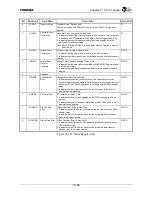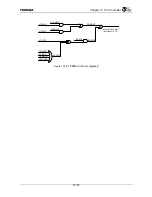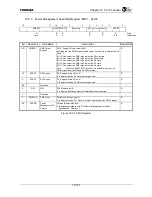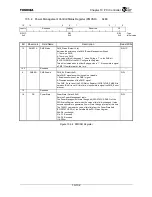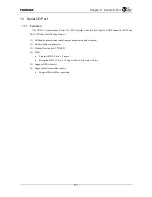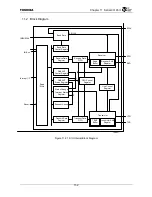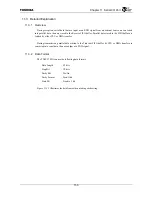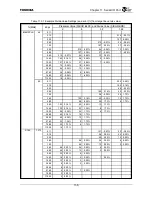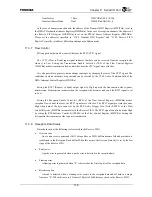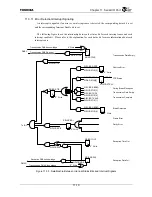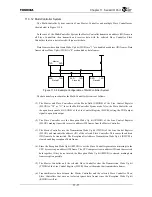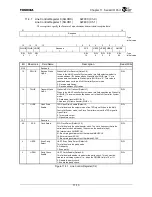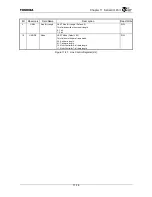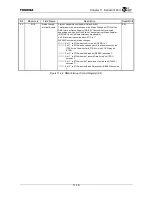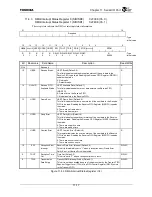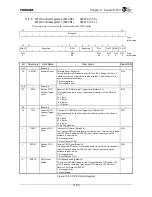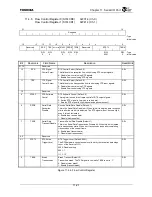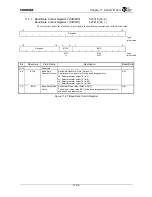
Chapter 11 Serial I/O Port
11-7
11.3.4 Data
Reception
When the Serial Data Reception Disable bit (RSDE) of the Flow Control Register (SIFLCRn) is set
to “0”, reception operation starts after the RXD signal start bit is detected. Start bits are detected when
the RXD signal transitions from the High state to the Low state. Therefore, the RXD signal is not
interpreted as a start bit if it is Low when the Serial Data Reception Disable bit is set to “0”.
The received data are stored in the Receive FIFO. The Reception Data Full bit (RDIS) of the
DMA/Interrupt Status Register (SIDISRn) is set if the byte count of the stored reception data exceeds
the value set by the Receive FIFO Request Trigger Level field (RDIL) of the FIFO Control Register
(SIFCRn).
An interrupt is signaled when the Reception Data Interrupt Enable bit (RIE) of the DMA/Interrupt
Control Register (SIDICRn) is set. The received data can be read from the Receive FIFO Data Register
(SIRFIFOn).
In addition, DMA transfer is initiated when the Reception Data DMA Enable bit (RDE) of the
DMA/Interrupt Control Register (SIDICRn) is set.
11.3.5 Data
Transmission
Data stored in the Transmission Data FIFO are transmitted when the Serial Data Transmission
Disable bit (TSDE) of the Flow Control Register (SIFLCRn) is set to “0”.
If the available space in the Transmit FIFO is equal to or greater than the byte count set by the
Transmit FIFO Request Trigger Level (TDIL) of the Control Register (SIFCRn), the transmission data
empty bit (TDIS) of the DMA/Interrupt Status Register (SIDISRn) is set.
An interrupt is signaled when the Transmission Data Interrupt Enable bit (TIE) of the DMA/Interrupt
Control Register (SIDICRn) is set.
In addition, DMA transfer is initiated when the Transmission Data DMA Enable bit (TDE) of the
DMA/Interrupt Control Register (SIDICRn) is set.
11.3.6 DMA
Transfer
The DMA Request Select field (INTDMA[7:0]) of the Pin Configuration Register (PCFG) can be
used to allocate DMA channels for each reception and transmission channel in the following manner.
SIO Channel 1 Reception
DMA Channel 0
SIO Channel 1 Transmission DMA Channel 1
SIO Channel 0 Reception
DMA Channel 2
SIO Channel 0 Transmission DMA Channel 3
Set the DMA Channel Control Register of the DMA Controller as described below.
DMA Request Polarity
Low Active
DMCCRn.ACKPOL = 0
DMA Acknowledge Polarity Low Active
DMCCRn.REQPOL = 0
Request Detection
Level Detection
DMCCRn.EGREQ = 0
Summary of Contents for TX49 TMPR4937
Page 1: ...64 Bit TX System RISC TX49 Family TMPR4937 Rev 2 0 ...
Page 4: ......
Page 13: ...Table of Contents ix TMPR4937 Revision History 1 ...
Page 14: ...Table of Contents x ...
Page 15: ...Handling Precautions ...
Page 16: ......
Page 18: ...1 Using Toshiba Semiconductors Safely 1 2 ...
Page 40: ...3 General Safety Precautions and Usage Considerations 3 18 ...
Page 42: ...4 Precautions and Usage Considerations 4 2 ...
Page 43: ...TMPR4937 2005 3 Rev 2 0 ...
Page 44: ......
Page 52: ...Chapter 1 Overview and Features 1 6 ...
Page 156: ...Chapter 7 External Bus Controller 7 56 ...
Page 491: ...Chapter 16 Removed 16 1 16 Removed ...
Page 492: ...Chapter 16 Removed 16 2 ...
Page 493: ...Chapter 17 Removed 17 1 17 Removed ...
Page 494: ...Chapter 17 Removed 17 2 ...
Page 495: ...Chapter 18 Removed 18 1 18 Removed ...
Page 496: ...Chapter 18 Removed 18 2 ...
Page 497: ...Chapter 19 Removed 19 1 19 Removed ...
Page 498: ...Chapter 19 Removed 19 2 ...
Page 506: ...Chapter 20 Extended EJTAG Interface 20 8 ...
Page 530: ...Chapter 22 Pinout and Package Information 22 10 ...
Page 542: ...Chapter 24 Parts Number when Ordering 24 2 ...


